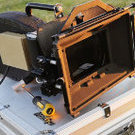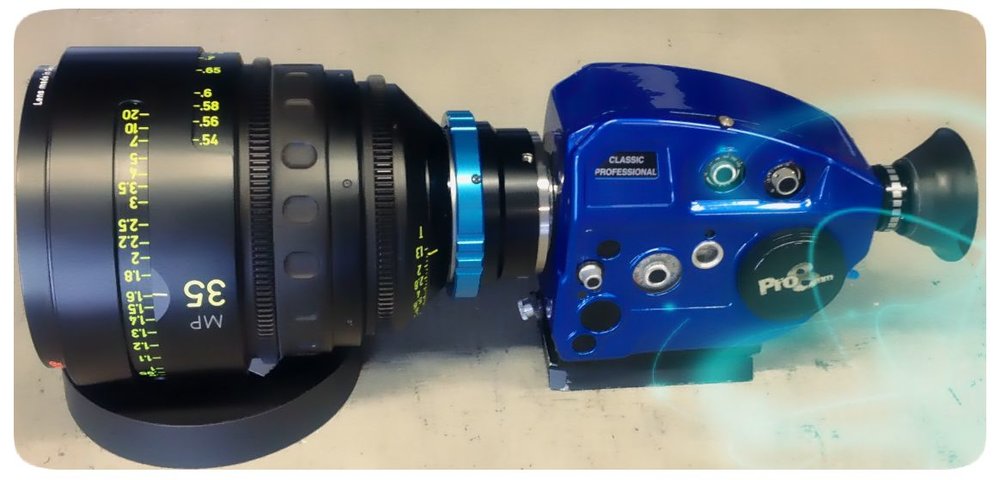
Daniel Henriquez Ilic
Basic Member-
Posts
82 -
Joined
-
Last visited
About Daniel Henriquez Ilic
- Birthday 08/27/1977
Profile Information
-
Occupation
Other
-
Location
Santiago, Chile
Contact Methods
-
Website URL
http://
Recent Profile Visitors
5,348 profile views
-
Thank you James for your comment and apologies for the long delayed answer. I have been missing the great Plus-X stock (7276 40 ASA) and whilst Tri-X 7266 is still an interesting stock, I wanted to test Double X black and white negative. The film was custom loaded to Super-8 by Pro8mm from Eastman Kodak Double X 5222 400 feet 35mm can.
-
I have shot the music video of "Ellos no pueden" (They can't), a song from Rezuzitaun new album of the chilean Hip Hop band Rezonancia. This music video, was entirely shot on film (except end credits), in Super 35 and Super-8 formats. Locations were Santiago de Chile, Viña del Mar and Unihue, Maule region. The stocks were Kodak 5203 (50 ASA daylight Vision3) in 35mm, and 7203 and Double X in Super-8 / Max-8. The XX black and white negative were custom loads of Eastman Kodak 5222; that I did request to Pro8mm. The cameras were Arriflex 435 Xtreme, a Pro8 Classic Max8 with a permanent PL to C Mount adapter, a Quarz 1x8S-2 and a Zeiss Ikon Moviflex MS8. On the 435 Xtreme we used mainly a Cooke 15-40 zoom and few shots with Carl Zeiss Ultra Prime 50mm and Master Prime 50mm. The Pro8 Classic camera was used with an Ultra Prime lens 50mm and with an Helios58mm (with PL adapter). All the 35mm footage was developed at FotoKem; whilst the Super-8 color negative was developed at Pro8mm. The super-8 XX black and white negative was hand-developed in Chile, into D-76 or Ilford DD-X (depending on the cartridge). In total around 1200 feet of 35mm color negative and around 190 feet of Super-8 were shot for this project. All the footage was then scanned to 2K1556 DPX RGB 16-bit Log/flat at the same great Labs in Los Angeles area. The digital intermediate post-production was done using the 2K DPX files; using a 1920x1080 timeline, within da Vinci Resolve 14 beta software (YRGB color science). Almost all the VFX work was done inside da Vinci Resolve with some auxiliary work done with AFX and Adobe Photoshop. The color grading was done using a Rec 709 monitor. This Music Video was broadcasted by a free to air TV channel in Santiago de Chile, a month ago and then released to internet via YouTube. Link:
-
Wasn't aware of that. So what would be its effective bit depth quantization in your opinion ? 14-bit per channel (in a 16-bit DPX container) ? BTW do you know any motion picture scanner capable of delivering true 16-bit ? In the photographic field the Flextight scanner are said to scan at 16-bit http://www.hasselblad.com/scanners/flextight-x5
-
Questione for experts of Fujica ZC 1000 camera
Daniel Henriquez Ilic replied to Luigi Castellitto's topic in Super-8
The spanish filmmaker Ignacio Benedeti Corzo knows a lot about Single 8 and the the Fujica ZC 1000. He published few days ago this entry in is blog http://mimundoensuper-8.blogspot.cl/2017/02/fujica-zc1000-manual-de-servicio-gratis.html regarding that camera and the maintenance guide of the camera. I copy his download link here : http://www.ibcinema.com/download/zc1000.pdf -
it would be also great if the camera could record Timecode in between the perforation of the film. 1 foot is equivalent to 72 frames in super-8 (50x72=3600 frames), timecode should be exposed in between perfs three times per foot (so each second)... this would require some R&D too at telecine/scanner stage to recover the timecode and to embed it to the DPX image sequence.
-
It would be interesting if the camera could have an interchangeable gate (but this may not be possible or recomendable). This would allow to continue shooting super-8/max8 with the same 50 feet (15.2 meters) cartridge, but changing the gate would allow to shoot 1.85:1 or even 2.35:1 with spherical lens. The idea is to replicate something like Paramount's VistaVision but in 8mm. Like a Vista8 new format. Changing the gate would also require to rotate the camera 90º, so the ergonomics and the functionalities of the camera would need to remain similar when rotating the camera. Challenging, but provided this is possible, then the effective image area would be much bigger than what is super-8 or max8. The potential is to use the equivalent of two current super-8 frames (aprox). I calculated with a physical super-8 piece of film thet the image wide, in an eventual "Vista8" format could be as much as 8mm whilst the height would be up to 5mm aprox. Through proper ground glass or a system like Aatonite or Arri Glow the Director of Photography could see the aspect ratio lines clearly visible on the viewfinder and video-assist. Sure, the cartridge would now have a duration of 75 seconds (at 24fps) instead of 150 seconds... but the improvement of image quality should be really apparent. However frame steadiness is a technical issue with super-8; so hopefully addressed on your camera design too. Other important consideration are sync speeds, the noise from the camera (when the film is running), as well as single frame exposure (hopefully with adjustable time up to several seconds or minutes).
-
Hi David, The widest non fish eye lens I have used with that setup (camera + adapter) is a Carl Zeiss Ultra Prime 8R. "The Ultra Prime 8R/T2.8 is an extreme wide angle lens with a unique look unparalleled by any other lens in the film or video world. Because of its rectilinear design it shows an extremely wide angle of view without any of the commonly associated fisheye distortions." source : https://www.arri.com/es/camera/cine_lenses/prime_lenses/ultra_prime_8r/ In case it could be useful for your project, I do have an old PL to C mount adapter (that is deffective at the C mount side) that I am not using for a while. You may eventually use the PL mount of it (provided you can remove the C-mount, and transform the lens adapter in just a PL-mount). I would be happy to support your research by providing this item as long as shipping and duties are paid by your end. All the best, Daniel Henriquez Ilic Fotoquimica Films SpA
-
DIRECT SOUND FILM AVAILABLE AGAIN
Daniel Henriquez Ilic replied to ignacio benedeti's topic in Super-8
It is great and encouraging to know about the current researchs around single-8 and super-8, including direct sound! -
creativity, the ability to make or otherwise bring into existence something new, whether a new solution to a problem, a new method or device, or a new artistic object or form (...) extract of "creativity" definition from www.britannica.com
-
Hello.. I have just seen this thread; I also look forward for a third generation 8mm film camera. A camera that accepts 8mm film without perforation, and where the image is exposed horizontally (16x9 and even up to 2.35), so a new format but still using 8mm film...... however that camera would also be compatible with super-8 cartridge, by rotating the camera 90 degrees. It is common that porfessional still cameras can be used horizontally or vertically Of course, a new 8mm format would require some upgrades from telecine and scanner manufacturer. From a top leading european camera manufacturer info, a new super-8 camera would cost around 15.000 Euros, per unit. I did propose some technical ideas and a format diagram on the final pages of the "Halogenuros" report ( www.filmhalogenuros.cl ) and that could certainly be improved with R&D. Concerning optics, I recommend PL-mount or a C-Mount camera + a good PL to C-Mount adapter (hopefully made by the same manufacturer of the camera) I did test a Carl Zeiss Ultra16 8mm with a Pro8 Classic camera (and adapter) on a local rental house, a few years ago and whilst it was still not really wide-angle for super-8, it looked very useful for cinema, and did not presented geometric distortion (rectilinear). May be a lower-cost camera, only for super-8, could be made using some of the components of the full version of the camera (dual format "as 8mm third generation" and 1964's super.8). A full version would be useful, for many professional applications as A camera, or additional camera where Super 16 o Super 35mm are the main formats. One possibility for financing the R&D could be , if possible, that the manufacturer(s) of super-8 film adds (a voluntary) USD 1 fee for each cartridge that is selled. The funding would then be sent to the manufacturer(s) with the compromise of delivering a prototype within a year. Greetings for 2011...
-
Hello, Greetings! great news from Steenbeck.... first time in about three decades they have built a new 8mm / super 8mm viewing table "ST 822".... it was shown at IBC 2010, Amsterdam. Here is the link http://www.steenbeck.com/3-7.html Chao, Daniel text from Steenbeck website : ST 822 The new series 8mm film viewing table, type ST822 is an ideal for film archives, film laboratories and film scanning studios. The new series 8mm features: New 2 plate, 2 picture film table with COMMAG sound. Designed from a proven concept, for extreme friendly film handling. Fast and accurate checking of film and sound. Separate film systems for Super 8 (S8) and Normal 8 (N8) (switchable) with large projection area each 230 x 160 mm (approx). Full frame projection. Lamp 12V / 100Watt. High quality projection screen. Standard with electronic universal processor counter. Standard with display for actual running speed of film. Standard with a safe built in film rewinder. Sound system: both 8mm formats with COMMAG sound mono: Super 8: 2 channels for main and balance track, with two faders Normal 8: 1 channel. summing amp. with treble, bass and master volume potentiometers. headphone ¼” jack. two balanced XLR mono outputs. two way high quality loudspeakers Switchable sync speeds 18 and 24 f.p.s. Varia speed from 0 till 100 f.p.s. (approx) For 8mm and Super8 film spools. Steel adapter for S8 spools. Ground glass back-illuminated by a 7000° K (approx) light source. Operating voltage selectable 100 - 240 V / 50 of 60Hz at 3 A.




